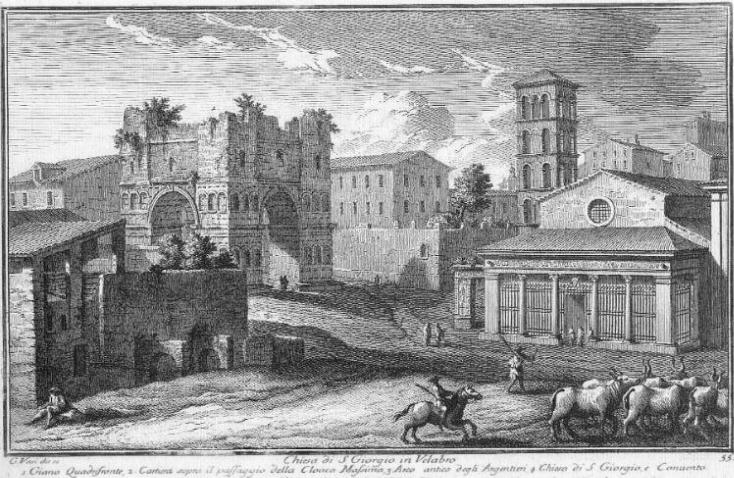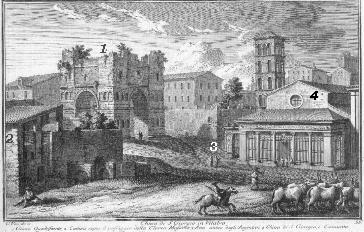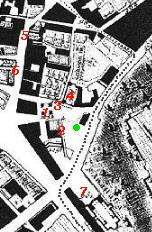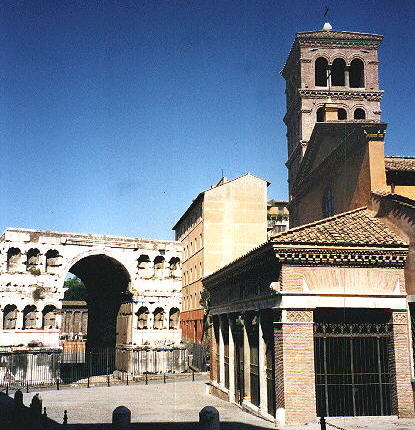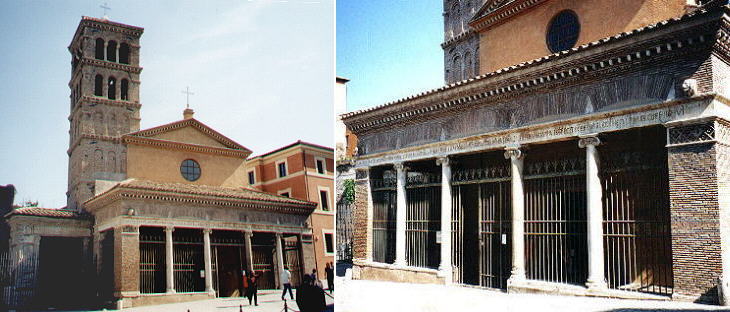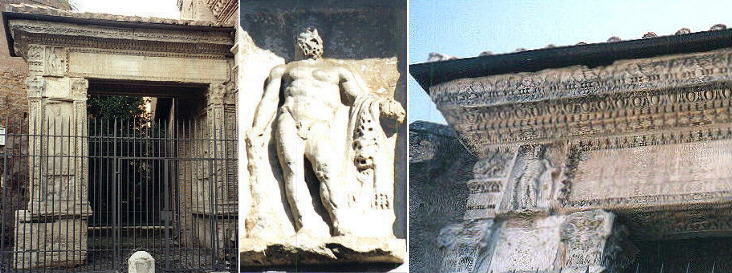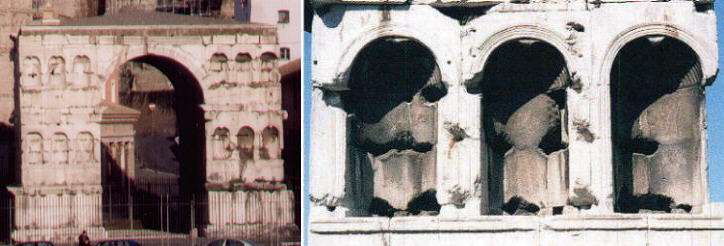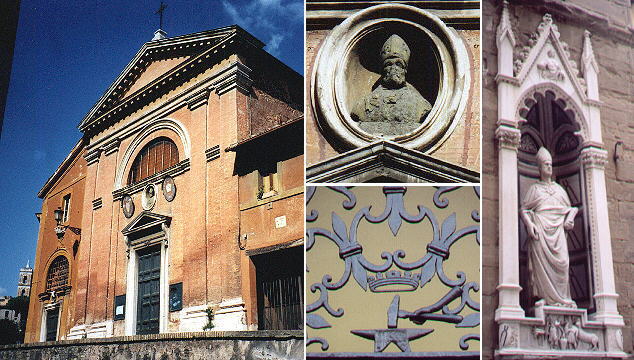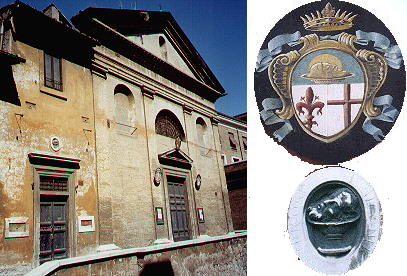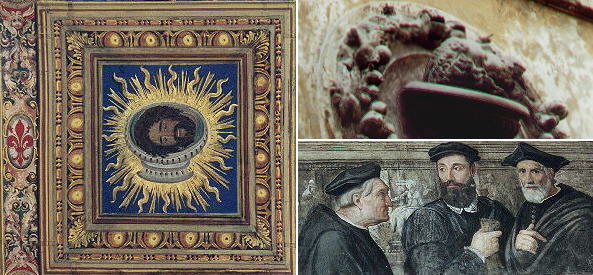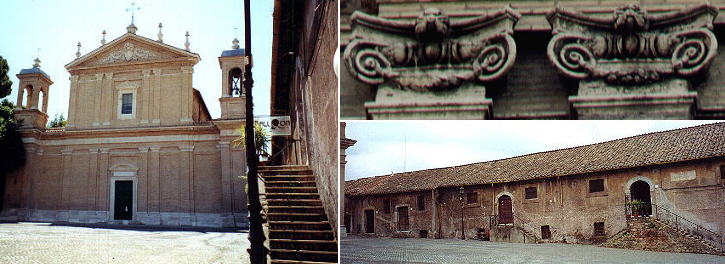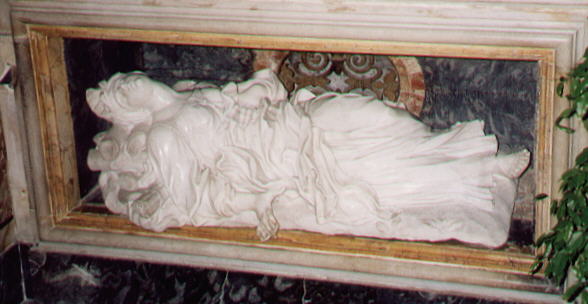

S. Giorgio al Velabro (Book
3) (Map
C3) (Day 5) (View C9) (Rione Ripa) and (Rione Campitelli)
In this page:
The plate by Giuseppe Vasi
Today's view
S. Giorgio al Velabro
Arco degli Argentieri
Arco di Giano Quadrifronte
S. Eligio dei Fabbri
S. Giovanni Decollato
S. Anastasia
The Plate (No. 55)
The area along the river at the foot of the Quirinalis and Palatinus
was marshy and here the Romans developed their drainage system by building
the Cloaca Maxima to collect the waters and channel
them to the Tiber. The flow of the water was used, in Vasi's time for
a paper-mill (on the left). Because of the nearby Campo
Vaccino (the Forum) it was common to see cattle being led there. The view is taken from the green dot in the small map below.
In the description below the plate Vasi made reference to: 1) Arco di Giano Quadrifronte;
2) The paper mill above Cloaca Maxima; 3) Arco degli Argentieri; 4) S. Giorgio al Velabro. The small 1748 map shows also:
5) S. Eligio dei Fabbri; 6) S. Giovanni Decollato; 7) S. Anastasia.
The dotted line in the small map delineates the border between Rione Ripa (left) and Rione Campitelli (right).
Today
The church and the arch (without the added top storey) have been
preserved whilst the paper-mill has been pulled down and the Cloaca Maxima
is no longer directly visible.
S.
Giorgio al Velabro
The church was built by the Greek community (like the very close
church of S.
Maria in Cosmedin) in the VIth century, while the portico (with nice
columns and a long inscription) and the bell-tower were added in the XIIth
century. The portico was severely damaged by an explosion a few years ago
but it has been thoroughly restored.
Arco degli
Argentieri
The little arch was erected by the Argentarii (money-changers) and
cattle dealers in honour of the Emperor Septimius Severus. It is a work
of art of the late Empire, as its nearly baroque decoration shows.
Arco
di Giano Quadrifronte
The arch has different names and was built around the reign of Constantine.
It is also called Arch of Massenzio, after Constantine's fiercest enemy. Giano (Janus) was the god of the passages (ianua in Latin means door): the arch dedicated to him had four fronts
instead of two (quadrifronte = four fronts).
The main purpose of the arch was to shelter the dealers. In the niches
there were statues of the gods (shortlived, because in a few years the
pagan gods were to be banned).
S.
Eligio dei Fabbri
Sant'Eligio is the patron of the blacksmiths (fabbri), but because
of the splits in their guild he is also the patron of the goldsmiths and
of the farriers. So he is honoured in S. Eligio degli Orefici (goldsmiths)
near Via Giulia, in S. Eligio dei Sellai (farriers)
(the church was pulled down at the beginning of the XXth century) and S. Eligio dei Fabbri (blacksmiths)
which you can see in this page. The blacksmiths were so proud of their
skills that above the entrance they wrote "Universitatis Fabrorum" (the
University of the Blacksmiths) (click here for a list of churches belonging to a guild).
In Florence the guild of the blacksmiths dedicated a statue (image on the right) to their patron in Orsanmichele (see my Florentine Recollections). The church is in the area between S. Giorgio
in Velabro and the Capitol.
S.
Giovanni Decollato
In Florence you do not call an ambulance, you call "La Misericordia"
a confraternity for helping the sick. The members are still hooded. The
Florentines living in Rome created their own local Misericordia (miserere=pity
cor, cordis=heart) named after the patron of Florence, St. John the Baptist
whose Decollation is shown everywhere in the church where the members meet.
The church and the adjoining oratory have a rich decoration and works by
Vasari and other Mannerist artists (click here for a list of national churches in Rome). The man
with the dark beard in the image below is thought to be Michelangelo, who was a member of the confraternity.
Read Charles Dickens's account of an execution near this church in 1845.
S.
Anastasia
Located at the foot of the Palatine, S. Anastasia dates back to 492
and it was thoroughly redesigned in 1636 by Gian Lorenzo Bernini for Urbanus VIII (whose heraldic bees decorate the pillars of the façade). Below the altar the statue of the saint by Ercole Ferrata is clearly
inspired by Bernini.
Excerpts from Giuseppe Vasi 1761 Itinerary related to this page:
Chiesa di s. Eligio
Era questa anticamente delicata a ss. Giacomo, e Martino, e vi era unito un conservatorio di povere
donne: ma poi ottenuta dalla Confraternita de' Ferrari nell'an. 1563. riedificarono la chiesa
da' fondamenti, ed ora l'hanno ornata con nobilissime cappelle di marmi e pitture. Poco più oltre si
vede a destra la
Chiesa di s. Giovanni Decollato
Prima dicevasi questa chiesa s. Maria della Fossa, perchè in essa si dava sepoltura a' giustiziati, che
allora si facevano morire sul vicino monte Caprino Ma essendo nell'an. 1487. da Innoc. VIII. approvata la
Confraternita della Misericordia eretta, e composta di nazionali Fiorentini, fu di nuovo edificata la
chiesa, e dedicata a s. Gio. Batista col titolo di Decollato, e comecchè il loro istituto è di assistere a ben
morire i condannati a morte, e dar loro sepoltura, vi eressero il cimiterio cinto di portici. Sonovi nella
chiesa, e sagrestia delle pitture del Vasari, del Salviati, del Pomarancio del Naldini, ed altri. Quindi
camminando a destra si vedono le rovine del
Giano Quadrifonte
Si ravvisa questo antichissimo edifizio tutto formato di marmo con quattro archi aperti ne' quattro
prospetti, ed in ogni prospetto dodici nicchie, e viene creduto essere il tempio di Giano Quadrifronte,
ma è più verisimile esser uno delli due fornici adorni di statue di oro, che fece Stertinio nel foro
Boario, che quivi si stabilisce dall'iscrizione, che ancor si legge
nell'arco fatto dagli Argentarj, e negozianti del medesimo foro Boario, quale ancora si vede
appoggiato alla
Chiesa di s. Giorgio in Velabro
Si dice in velabro questa chiesa a vehendo, poichè fu quivi una palude o stagno del vicino Tevere, in
cui furono spinti i due fanciulli Romolo, e Remo dalle onde in quel tempo fluttuanti, e però si tragittava
colla barchetta; seccata poi la palude da Tarquinio Superbo, vi fu eretto il foro Boario, in cui fu alzato un
vitello di bronzo dorato, in memoria di aver ivi Romolo coll'aratro tirato da un bue, ed una vacca
principiato il solco per segnare le mura di Roma.
Fu quivi la casa di Scipione Affricano, la quale comprata poi da Tito Sempronio, vi edificò una
basilica, che fu detta Semproniana, sopra le cui rovine essendo edificata la chiesa s. Leone II. la
dedicò a s. Sebastiano, ed avendola poi il Pontefice s. Zaccaria ristaurata, vi aggiunse il titolo di
s. Giorgio, per essere entrambi difensori della Chiesa. Fu da principio collegiata insigne, ma ora vi è
unito un convento di frati Agostiniani Scalzi. Si legge, che quivi, come dicemmo, nel foro Boario
stette per tre giorni insepolto il cadavere di s Bibbiana. Lo scavo, che si vede sotto la cartiera, è
avanzo della Cloaca massima, e l'acqua è del fonte di Giugurta.
Chiesa di s. Anastasia
Circa l'anno 300. si tiene, che fosse fabbricata quivi una piccola chiesa da Appollonia Matrona
Romana per dare sepoltura alla santa Vergine, e Martire, e fu tenuta con tanta venerazione da' Sommi
Pontefici, che nella notte del ss. Natale di Gesù Cristo, dopo aver detta la prima messa in s. Gio. Laterano,
venivano in questa a celebrare la seconda nell'aurora. Si conservano in essa il pannolino, con cui
la ss. Vergine involte il ss. Bambino, parte del mantello di s. Giuseppe, ed ancora il calice, col quale
celebrava s. Girolamo, mentre vi dimorò da Prete. Fu poi eretta a tre navate ornata di belle colonne
di marmo antiche, e da Urb. VIII. fu rinnovata col disegno del Cav. Bernino, il quale fece il nobile
prospetto; dal Card. Nunno d'Acunha Portoghese essendone titolare, fu adornata notabilmente anco
la sagrestia. Nella tribuna si vedono de' marmi, e busti di metallo, e due preziose colonne; le pitture
sono di Lazzaro Bardi, e la statua della Santa a giacere sotto l'altare fu l'ultima opera di Ercole Ferrata,
terminata però da Francesco Aprile Milanese.
Presso di questa chiesa essendosi nel 1526. scoperta una nicchia con conchiglie marine, si suppose
essere stata del tempio di Nettunno; ma è sicuro, essere stata quì presso l'Ara Massima, cioè quel
gran sasso, o altare drizzato da Ercole in compagnia di Evandro dopo l'uccisione di Cacco, e dicevasi
così, perchè veramente era grandissimo, e fu celebre sopra tutti gli altri, perchè drizzato alla Fede, che
davasi di amistà reciproca. Questi siti, che ora vediamo occupati da' fenili, orti, e vigne, erano in quei
tempi, che la Romana Repubblica fioriva, li più abitati, e perciò pieni di edifìzj stupendi, e memorabili;
ma comecchè anderebbe troppo alla lunga, se almeno volessimo accennarli, ci contenteremo per ora
delle principali, e più rimarchevoli. Dal divisato tempio di Romolo e Remo principiava la famosa Via
Nuova, e andava ad unirsi colla Appia; e nello tra quel tempio e l'Ara massima, tra la Regia di Numa,
la casa di Tarquinio Prisco, ed il gran ponte di Caligola fatte per andare dal Palatino al Campidoglio.
|
Next plate in Book 3: Chiesa
di S. Maria in Cosmedin
Next step in Day 5 itinerary: Chiesa di S. Teodoro
Next step in your tour of Rione Ripa: Circo Massimo
Next step in your tour of Rione Campitelli: Chiesa di S. Maria Liberatrice

Go
to  or to Book
3 or to my Home
Page on Baroque Rome or to my Home Page on Rome
in the footsteps of an XVIIIth century traveller.
or to Book
3 or to my Home
Page on Baroque Rome or to my Home Page on Rome
in the footsteps of an XVIIIth century traveller.
|


